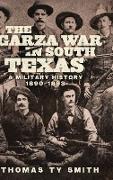The Garza War in South Texas
BücherAngebote / Angebote:
South Texas and northern Mexico formed a seedbed of revolt in the late nineteenth century. In the 1890s, two decades after he had launched his own successful revolution from South Texas, Mexican president Porfirio Díaz faced a cross-border insurgency intent on toppling his government. The Garza War, so named for the revolutionary firebrand and editor Catarino Erasmo Garza, actually comprised three concerted Texas-based attempts to overthrow Díaz: a June 1890 raid led by Francisco Ruiz Sandoval, the Garza Raid of September 1891, and the San Ignacio Raid of December 1892. In the first detailed military history of the Garza War, Thomas Ty Smith reveals how an armed insurrection against a foreign government, conducted on American soil, drew the US Army into a uniquely complex conflict whose repercussions would be felt on both sides of the US-Mexico border for generations to come.
Though not intended as a direct threat to the US, by using Texas as a staging area, the insurgency threatened US neutrality laws, forcing the US to honor its treaty obligations to the Porfirio Díaz government in Mexico City-a proposition further complicated by the Posse Comitatus Act of 1878, which prevented soldiers from acting as law enforcement. Smith describes how what began as a measured and somewhat limited effort by the United States to enforce the Neutrality Act in Texas eventually escalated into an all-out shooting war between the army and the Garzistas, elevating the counterinsurgency campaign into the highest military, diplomatic, and political echelons of both America and Mexico.
The Garza War in South Texas profiles central characters in the conflict-such as Captain John Gregory Bourke, famed for his service with Major General George Crook in the Indian Wars, the biracial, bilingual Shely brothers, former Texas Rangers who ran the army's secret spy network, and Francisco Benavides, aka El Tuerto (One-Eye), leader of the 1892 raid that resulted in the brutal slaughter and burning of a Mexican federal cavalry outpost across the river from San Ygnacio, Texas. These revolutionaries provided a cornerstone ideology, and a historic legacy, for the Mexican Revolution two decades later.
Folgt in ca. 15 Arbeitstagen
